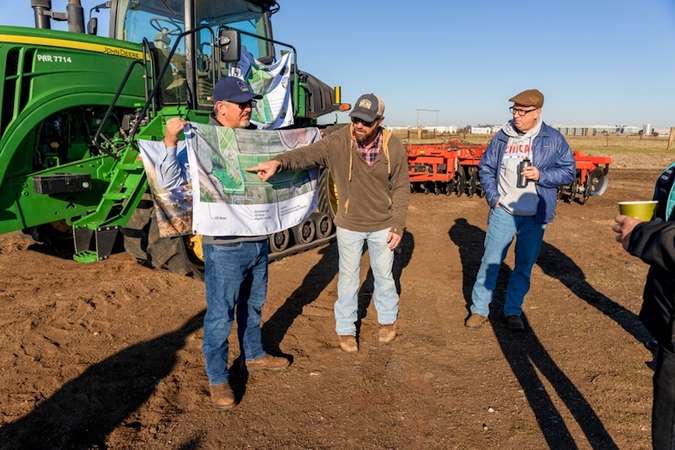
Land has been tilled at UC Merced’s smart farm, the first physical step in developing the state-of-the-art project.
“Even though it’s just a blank field, we have overcome some pretty big obstacles to be where we are today,” said Danny Royer, Experimental Smart Farm coordinator for the university. He spoke Nov. 16, at the farm, describing the work done so far and what’s next.
Plans call for the farm to grow oats, grain, tomatoes and squash. But the primary crop for the 45-acre property roughly a half-mile south of campus will be data.
Conditions will be monitored, and a dashboard will be created that student researchers can access.
“We can look at different pest control strategies, different watering strategies, knowing that the smart farm is keeping track of all this background information,” said Professor Tom Harmon, who co-leads the smart farm with Professor Joshua Viers.
“We want the farm to operate on two levels,” Harmon said. “One, it should be tracking itself as a system in terms of water-energy work. And then at the process level you can come in and do very detailed research for that.”
The information that comes out of the farm will then be used to determine new experiments.
“Data will be going back to campus, and students will be able to run simulations and transfer that back,” Viers said.
But first, the initial crops must be planted.
Planting will start soon, Royer said, after the invasive weeds star thistle and juncus grass that have taken over the area are mitigated.
“Really, if we wanted to mitigate it the way I’ve been taught to mitigate it, we would disk this and leave it fallow for three years,” he said. “We don’t have three years so we’re going to have to deal with this in other ways, such as discing multiple times.”
In the meantime, soil samples have been taken and data is being collected to establish baselines for research.
The initial crop plan calls for a winter forage, “kind of an oat-wheat mix,” Royer said. “Winter forage is great — the crop residue is heavy in organic matter.” This helps the soil regenerate.
“The more organic matter we can start incorporating at the beginning, the better.”
The university is working on establishing a memorandum of understanding with Merced College, allowing students there to cut and bale the hay, which would then be sold to the owner of the cattle that will graze the area.
The cows are another important part of the plan, Royer said. Livestock activity also helps the soil regenerate.
Plans also call for four acres of intensive row crops, such as tomatoes, squash, melons and corn. These products can ultimately be used for community supported agriculture, or CSA boxes that will be sold.
Longer term, the farm is set to host farmers markets and other public-facing activities, as well as provide experiences for students outside of those who will directly use the data.
“One of my favorite features is an observation tower,” Viers said. The tower was requested by the humanities department. Students will be able to view the farm from above for sketching and other activities.
But building out all the plans will cost money.
“We have funds to do the initial infrastructure and buy or lease some equipment,” Royer said.
Full buildout would cost tens of millions, Harmon and Viers estimated.
“We’ll be seeking help from the community, sort of a virtual barn raising, to gather the necessary funding,” Harmon said.
They are also exploring funding sources such a research grants to pay for it. UC Merced’s recent designation as an agricultural experiment station (AES) will open other avenues of funding. University of California President Michael Drake recently announced that the Merced and Santa Cruz campuses have received the prestigious designation, the first time it’s been earned in more than 50 years.
The smart farm is UC Merced’s AES facility.
“With the AES designation, Santa Cruz and Merced have the potential additional funding from the University’s budget for (agricultural) research, and they will be able to make a stronger case for competitive grants in the larger research area,” Drake said.



